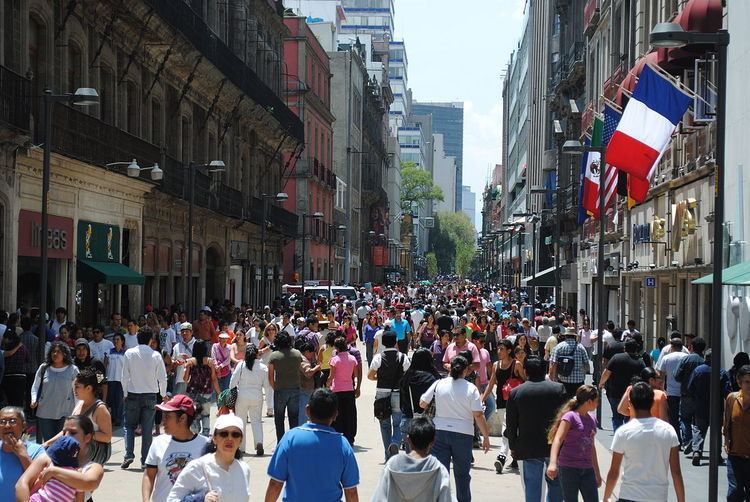Type Pedestrian Nearest metro station Bellas Artes, Zócalo Inaugurated 1862 | Length 700 m (2,300 ft) Postal code 06000 Namesake Francisco I. Madero | |
 | ||
Former name(s) Calle de La Profesa, Calle de San Francisco, Paseo de Plateros Location Historic center of Mexico City MEX East end Zócalo (Constitution Square) Similar Historic center of Mexico City, Casa de los Azulejos, Torre Latinoamericana, Palace of Iturbide, Zócalo | ||
A short walk along mexico city s avenida francisco i madero in the centro historico
Francisco I. Madero Avenue, commonly known as simply Madero street is a geographically and historically significant pedestrian street of Mexico City and a major thoroughfare of the historic city center. It has an East-West orientation from Zócalo to the Eje Central. From that point the street is called Avenida Juárez and becomes accessible to one-way traffic from one of the city's main boulevards, the Paseo de la Reforma.
Contents
- A short walk along mexico city s avenida francisco i madero in the centro historico
- Map of Av Francisco I Madero Centro HistC3B3rico Centro 06000 Ciudad de MC3A9xico CDMX Mexico
- Description
- Names
- Pedestrianisation
- Notable buildings
- References
Map of Av Francisco I. Madero, Centro Hist%C3%B3rico, Centro, 06000 Ciudad de M%C3%A9xico, CDMX, Mexico
It was named in honour of one of the most important figures in the Mexican Revolution - Francisco I. Madero, a leader of the Anti-Re-election Movement and who was briefly President of Mexico before his assassination in 1914.
Description
This street has always been one of the most popular and busiest roads since colonial times and was designed by Spaniard Alonso Garcia Bravo. It was one of the first streets to be drawn of the new Spanish city on the ruins of the Aztec capital Tenochtitlan.
In the nineteenth century, Madero was already one of the most popular and crowded streets of the capital. In many buildings concurred popular sites like the Casa de los Azulejos, home of the famous Jockey Club or imported products stores, some of which exist until today as the "Pastelería El Globo" (El Globo Pastry) and "Sombreros Tardán" (Tardán Hats). Another famous store was "Droguería Plateros" (Plateros Drugstore) at 9 Second Street of Plateros. In its upper part, Ferdinand Bon Benard and Gabriel Veyre, dealers of Lumiere Brothers, gave on August 14, 1896 the first cinema show in Mexico.
There are chronicles about the popularity of the Madero street as a social point of meeting written by José Joaquín Fernández de Lizardi, Guillermo Prieto, Manuel Gutiérrez Nájera and Luis G. Urbina, among others.
Names
Three sections of the street have each had previous names. The Western half of the street, between the current Eje Central Lázar Cárdenas (named San Juan de Letrán street at the time) and Bolívar street, was called "First and Second Street of San Francisco" after the large church and monastery complex at that location. Further East, between Bolívar street and Isabel la Católica street, was known as "Profesa street" after the Temple of San Felipe Neri (commonly known as "La Profesa") which is located there. Finally, the section between Isabel la Católica street and Zócalo (Constitution Square) was known as "Calle de Plateros" (Silversmith's road) after the silver jewellery worshops and stores established in that block after an ordinance given by the viceroy Lope Díez de Armendáriz, in the seventeenth century.
The present name was bestowed by Francisco "Pancho" Villa on the morning of December 8, 1914, after the arrival of his troops and Zapata's Liberation Army of the South to Mexico City. Villa and a small group of troops placed a plaque with the new street name on the corner of Madero and Isabel la Católica streets. They announced that whoever removed the plate would be shot.
Pedestrianisation
In 2009 Alejandra Moreno, the coordinator of the Historical Center Authority, announced that the city government would pedestrianise the street. Though resisted by shop owners at the time, the change has been a success with the street being very crowded with pedestrians and increases in real-estate value for landholders. In 2012 the modifications were awarded by the VIII Iberoamerican Biennial of Architecture and Urbanism (BIAU) for best architectural and urban development.
Notable buildings
The centrality of the street, both geographically and culturally, has meant it has always been a site of mansions, churches and important buildings.
From West to East these include:
